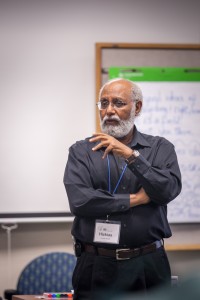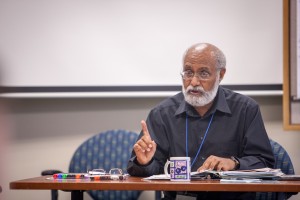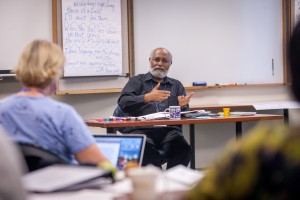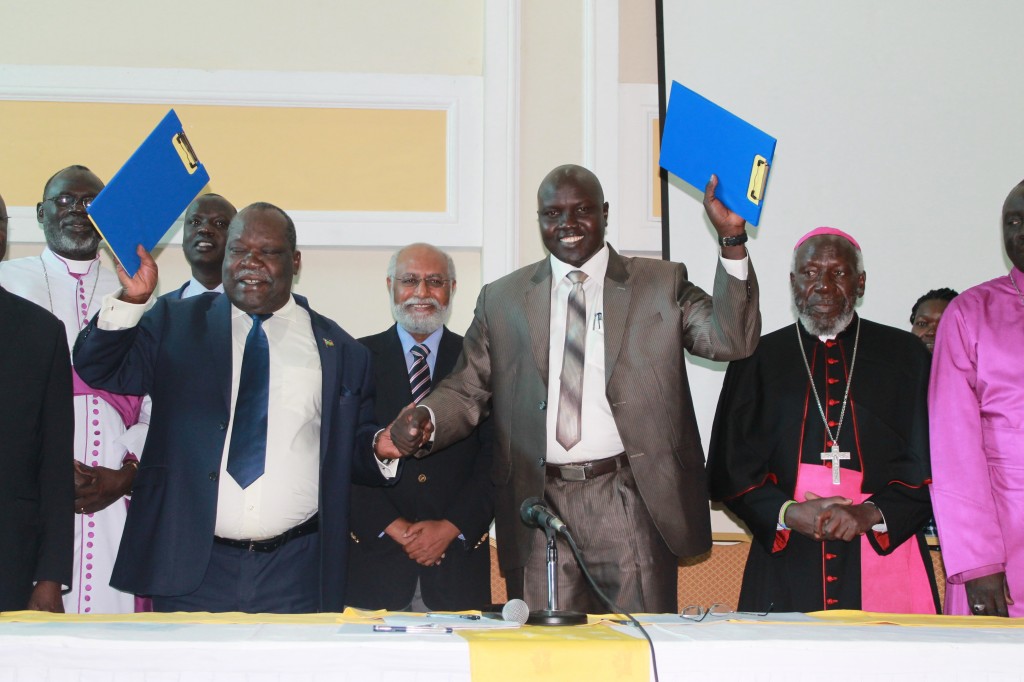Professor Hizkias Assefa responds here to questions about his successful efforts as a mediator to bring peace in early May 2014 to one large swath of South Sudan.
Assefa’s key role in ending a conflict that had displaced over 100,000 persons and killed unknown numbers of civilians was highlighted by Bishop Paride Taban, chair of the Church Leaders Peace Initiative in South Sudan, in a June 2, 2014, letter to a Dutch organization that funded the mediation process. “I would also like to express my deep gratitude for the mediation services of Professor Hizkias Assefa,” wrote Taban. “It was a privilege and honor for us to work with a man of his professional caliber and personal integrity – and indeed he was instrumental in ensuring the success of these negotiations, and thus the successful conclusion to this conflict. We would not have succeeded without him.”
Assefa is a founding faculty member of the Center for Justice and Peacebuilding at Eastern Mennonite University. For nearly two decades, he has taught courses on conflict transformation and reconciliation through EMU’s annual Summer Peacebuilding Institute. The following represents a series of exchanges between Assefa and EMU’s editor-in-chief Bonnie Price Lofton during early June 2014.

Lofton: In brief, what was the result of the seven months of mediations you just finished facilitating between representatives of the Government of the Republic of South Sudan and the South Sudan Democratic Movement/Army?
Assefa: The two parties signed a comprehensive peace accord on May 9, 2014. This means that the war that has involved thousands of armed combatants and has killed and displaced hundreds of thousands of civilians over the past four years has come to an end.
Lofton: But I keep reading about continued warfare, with massive numbers of displaced peoples, in South Sudan.
Two wars in South Sudan lately
Assefa: There have been two wars going on simultaneously in South Sudan lately. One is the outburst of violence that started on December 15, 2013, between the followers of President Salva Kirr of South Sudan and the followers of his former vice-president, Riek Machar. The conflict started over disagreement on governance issues but degenerated into a war between the two majority ethnic groups, the Dinka and Nuer. This conflict has been under the ongoing mediation of IGAD, the Intergovernmental Agency for Development, an eight-country regional political and economic bloc in Eastern Africa.
Lofton: I believe that is the one I have been hearing about in the U.S. media.
Assefa: It is the conflict that most people know about, and [it is] the one that John Kerry (U.S. Secretary of State) has commented upon publicly. But the war that we are talking about here and the one in which I was involved as a mediator is different and there has not been much international media coverage of it.
Lofton: Could you say more about this war?
Assefa: The central Government of South Sudan has been fighting an insurgency group called the South Sudan Democratic Movement/Army. The SSDM/A fighters are based in the largest state of South Sudan, Jonglei, and are primarily composed of the Murle, Anuak and other small ethnic groups around the Pibor, and to some extent, Pocholla and Akobo regions. Their grievances have revolved around ethnic marginalization and discrimination, as well as massive underdevelopment of their area. In other words, they have not benefited from the fruits of independence like some other major ethnic groups.
Lofton: When did this insurgency emerge?
Assefa: The SSDM/A rebellion emerged about four years ago, during the interim period when South Sudan was autonomous but not fully independent from Khartoum. This rebellion became exacerbated when the South Sudan government, soon after independence, decided to disarm former militia groups that fought with it against Khartoum. The disarmament process involved some massive human rights abuses that led to many deaths and destruction especially among the Murle population. This further embittered the community against the government and pushed them to join the groups that were already in the bush. The rebels called for the creation of their own autonomous state where they would control the resources in their region and exercise self-determination. They also called for the federalization of South Sudan. Their insurgency was supported by training and arms from Khartoum, against whom they had formerly fought for independence. Obviously, Khartoum had its own reasons for supporting the insurgency.
Lofton: How did you come to be involved in the peace talks?
Encouraged by church leaders to mediate

Assefa: On different occasions the insurgents, led by General David Yau Yau, called for mediation by the African Union, UN and USA. But, in the end, it was the Church Leaders Peace Initiative in South Sudan, with the support of the United Nations Mission in South Sudan (UNMISS) and a Dutch Organization called Pax (formerly IKV Pax Christi), that contacted me to act as mediator. I spent months traveling back and forth among the significant decision makers within the opposing parties in an effort to win sufficient trust and to enable talks to begin at a neutral site in Addis Ababa, Ethiopia.
Lofton: Somebody had to pay for the transportation, hotel rooms, food, your time and so forth. Where did the funding come from?
Assefa: The Government of the Netherlands through a Dutch International NGO called Pax funded the process. The European Union also paid for some phases of the mediation.
Lofton: When did talks formally begin?
Assefa: Contacts with the leadership of both sides had started in October 2013 and aimed at developing trust, softening the ground, and developing a shared understanding for the mediation process. By early January 2014, both parties were persuaded to appoint delegates and start the formal talks in Addis Ababa, Ethiopia. After very intensive negotiations, the first phase of the mediation culminated in the signature of a Cease Fire and Cessation of Hostilities Agreement on January 30, 2014. This agreement has held up well. From January until now, there have been no serious violations. In fact the militaries of both sides have cooperated very well to deliver humanitarian assistance to the area where this assistance has been very badly needed.
Lofton: You referred to an agreement signed on May 9. How is it different from the earlier agreement signed in January?
Latest agreement deals with underlying issues
Assefa: Since February, I’ve been working with the negotiating teams of both parties to address the underlying political, economic, socio-cultural as well as military and security issues underlying the conflict so that the ceasefire can be transformed into durable peace. The comprehensive peace accord signed on May 9, 2014, includes the following six provisions:
1. An autonomous region, with the status of a state, was created for the people represented by the insurgency. The new region is to be composed of six counties. This region will have its own executive, headed by an administrator, who will have the status of a governor, and who will report directly to the president of the country.
2. The region will also have its own independent legislature and judiciary.
3. The region will administer the resources and revenues derived from its territory.
4. A Special Economic Development Fund will be created to enhance the development of the region, with a focus on education, health and infrastructure.
5. Affirmative action will be employed to increase the participation of the marginalized groups in national governance and power sharing.
6. Most of the insurgents will be integrated into the regular military, but some of them will stay in the newly created region to ensure citizens’ security.
Lofton: Do you have concerns that what has been agreed to on paper might not be implemented on the ground?

- Hizkias Assefa teaching a course on forgiveness and reconciliation at the 2014 Summer Peacebuilding Institute. (Photo by Michael Sheeler)
Dispute resolution, monitoring, mechanisms
Assefa: There is always that danger in peace agreements. There could be a multitude of factors, both internal and external, that could undermine the peace agreement; and some of these factors are beyond the control of the conflict parties. In this case, it seems that the peace agreement has met the stated interests of both parties and I believe that both parties have the incentive to ensure that the agreement is not undermined. Moreover, we have tried to anticipate problems at the implementation stage and have put mechanisms in place to address them. So we have provided in the peace agreement a very strict implementation schedule, identifying who will do what by when, and created monitoring and dispute resolution bodies which will deal with emerging problems as soon as they arise so that they do not degenerate and threaten the whole peace accord. Representatives of the negotiating parties and local and international bodies, such as the United Nations, will be involved as monitors and overseers of the implementation process. Hopefully, these steps will help reduce implementation problems. However, despite all these, there cannot be a full-proof guarantee that things will work as planned. If the parties were genuinely involved in the mediation process, one hopes that they would have learned some problem-solving lessons that they would be inclined to use when implementation problems arise instead of racing to start another war again.
Lofton: You’ve been a mediator at all levels of global conflict for nearly 40 years. How does this process compare to others that you’ve been associated with?
Assefa: One remarkable thing that stood out for me in this mediation was the very positive and enabling relationship with the funders. The funders had a very good understanding of the mediation process and their style of funding enhanced instead of stifled it. Some funding comes with so many strings attached, the mediator finds his or her hand tied and is left to wonder whether ultimately his or her accountability is to the integrity of the process or the demands of the paymaster. Luckily, I did not have to face that dilemma in this mediation.
Lofton: What factors might have helped this mediation process conclude successfully?
Assefa: There were several factors. Among others, the sincerity of the negotiating delegates. They were properly mandated for their task and they managed to persuade their leading stakeholders to back up the concessions or agreements they were making in the process. Another key one was the high level of trust and support that I enjoyed among the parties. Because of this trust, I was able to explore and the parties were willing to try different approaches and options, including those they had initially rejected – they were open to using problem-solving strategies instead of resorting to highly positional bargaining. Periodically, we used to have separate sessions with each party where the parties would open themselves up to look at the problems from the eyes of the other side, using the perspectives of the mediator as a reality check.
In a strange way, a factor that could have also helped may have been that the mediation was low key and was taking place below the radar. The other conflict [between President Salva Kirr and his former vice president, Riek Machar, being mediated by IGAD] has been attracting a lot of international attention and has become a highly politicized process playing itself out in the media. Many powerful actors – such as the IGAD governments, the African Union, the UN, the U.S., Norway, the U.K., and other governments – have been involved in various capacities, pushing, threatening and cajoling, supporting their favorite side of the conflict and even indirectly pushing their own political agendas through the mediation. This, I believe, gives very little room for a genuine mediation process that pays attention to the essential underlying deep interests of the conflict parties. The coercion and pressure used by the mediators and the other governments involved seems to have backfired and has only created more covert resistance than cooperation.
Lofton: So, just to be clear, you feel that “pushing and threatening” are ultimately counter-productive?
Assefa’s only tools: persuasion, patience and persistence
Assefa: Yes, in the process I was guiding, there was no option for coercion or threatening the parties even if I had wanted to. My only tools were persuasion and working hard to help the parties forge solutions that genuinely met their interests and needs so that it was in their interest to adopt those solutions. The fact that our process was insulated from coercive international interference helped a great deal.
Lofton: Talk more about the hard parts of arriving at this agreement.
Assefa: Notwithstanding some of the positive elements in the mediation process that I mentioned earlier, those favorable circumstances did not present themselves consistently throughout the process. Amazingly, and for reasons that are hard to explain, the process felt like a see-saw. One day, hopes would be raised and the successful completion of the process would be joyfully visible to everybody. The next day, something would happen, the old fears and resentments would surface, we would spiral to the bottom, and anxieties about the imminent collapse of the process would abound. At times, it felt as if one is at a spot where movement forward seems impossible but admitting defeat and removing oneself from the scene was not an option. In the background of all this was also the gnawing awareness that the people at the grassroots of this conflict were hungry for peace.
There were many moments during the mediation process when I was vexed by the thought of what would happen if the mediation process failed and we could not deliver this peace that the people were hungry for. How could we face the disappointment of the people and what would be the consequences of such disappointment? I was painfully aware of the consequences of failed mediation from the Ethiopian-Eritrean war, a couple of decades back, where the collapse of the mediation process gave the impression to the parties that mediation was a waste of time, and that the only option left to the combatants was to use maximum force in order to achieve their goals. This led to a huge escalation of the war and an unbelievable human and material disaster.
Lofton: On a personal level, what is the significance of this latest mediation process to you?
Assefa: First, I feel fortunate that I was able to accompany and guide this process from its preliminary stages all the way to the final peace accord. One could learn a great deal about the anatomy, dynamics and life cycles of peace processes if one has a chance to work with them as they evolve. It is a rare opportunity for one to accompany these processes through all the stages. Many processes start in a positive way and then get bulldozed and taken over by other processes initiated by other actors for a multitude of motives. Therefore, in many political mediation initiatives, lots of energy goes into re-starting these processes, often again and again, rather than building on what was accomplished and moving forward.
Secondly, in terms of my own career in this field, I feel like I have completed some kind of a mystical cycle. For my doctoral studies in the late 1970s, I focused on the first Sudan civil war and the mediation to end it, which took place in 1972 in Addis Ababa, Ethiopia. Now 42 years later, I found myself mediating on Sudanese issues – although these issues are very different from the ones dealt with in 1972 – trying to put in practice what I studied theoretically years earlier, and mediating in the same city and even same hotel where the 1972 agreement was negotiated and signed.
Lofton: Any final thoughts?
Assefa (with a smile): I am not sure what this coming full circle is telling me. Is it possibly telling me that the cycle is complete, that it is time to pursue life in a different direction?

I enjoyed reading the story. I feel very encouraged and proud to have met Prof Hizkias and took Forgiveness and Reconciliation class in June 2013 which was led by him. Congratulations Prof. Hizkias for the success. God Bless you and EMU.
Very refreshing to learn of mediation that is being effective on the world stage. Just wish this would make the national news.
Agree with you. It seems that the successes — especially the times of heading off impending violent conflict — do not get publicized, only the discouraging developments in the world. Appreciate your comment.
Important reflections! I had been on the edges of the Sudan conflicts in the late 1960s when the World Council of Churches and the All African Conferences of Churches were working on what led to the 1972 Addis agreement which led to a 10 year cease fire. Unfortunately, the decade was not used to deal with root causes, and the North/South civil war started up again in 1982., Again, as an NGO representative to the UN, Geneva, I was involved at the edges in the on-going Darfur, Sudan conflict. I think, as pointed out in the interview, that church-related people can play a positive role in mediation but must continue to help in the post-armed conflict period. The Central African Republic has a current need for positive action.
Well reported! Thank you, Bonnie, for covering this important story, and thanks to Prof. Assefa for his committed and faithful work.